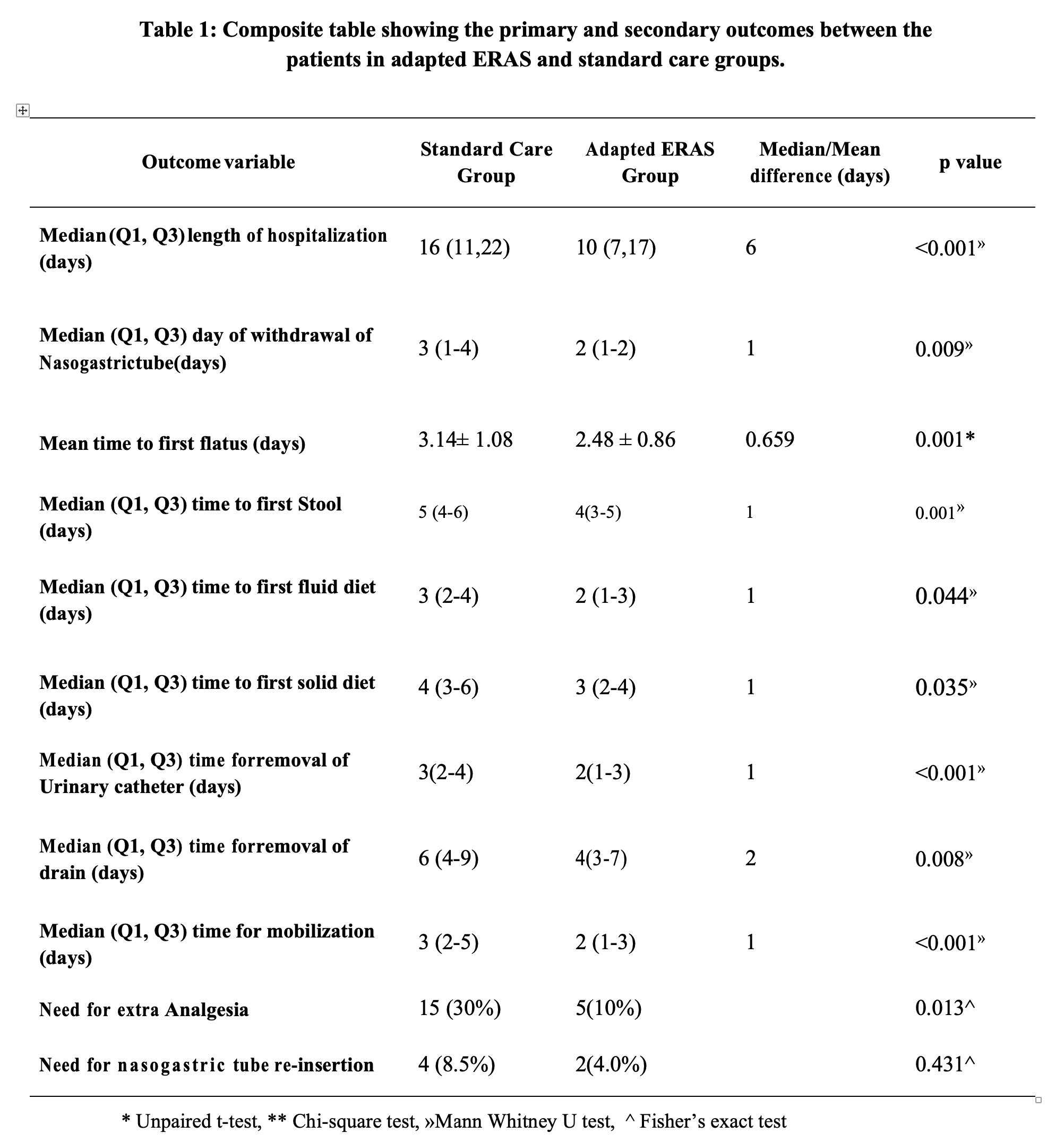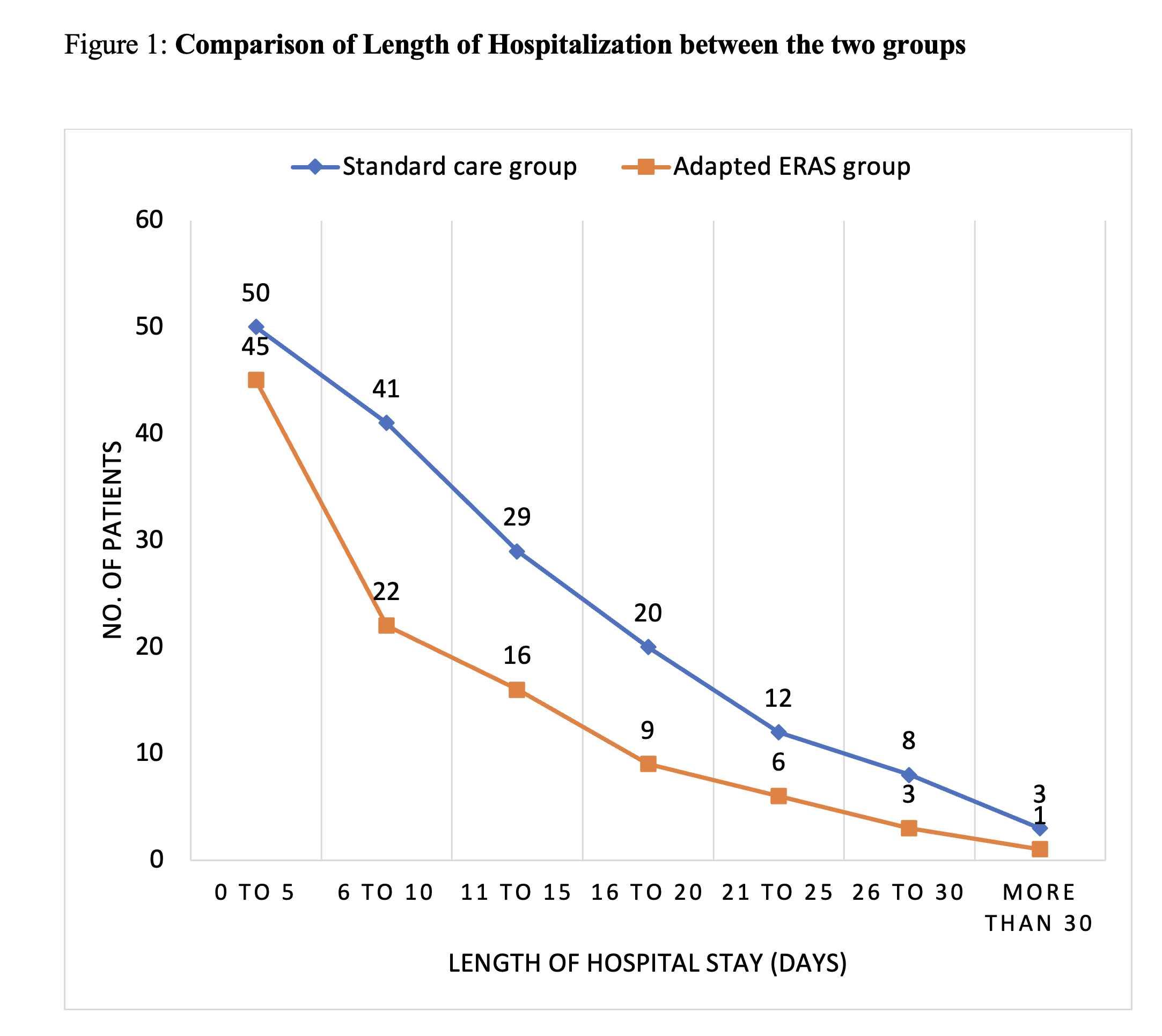Back to 2024 Abstracts
COMPARISON OF ADAPTED ENHANCED RECOVERY AFTER SURGERY (ERAS) PATHWAY VERSUS STANDARD CARE IN PATIENTS UNDERGOING EMERGENCY ABDOMINAL SURGERY – A RANDOMIZED CONTROLLED TRIAL.
Vikram Kate
*1, Likhita S. Singh
1, Gurushankari Balakrishnan
2, Sathasivam Sureshkumar
1, Amaranathan Anandhi
1, Thulasingam Mahalakshmy
3, Pankaj Kundra
41Department of Surgery, Jawaharlal Institute of Postgraduate Medical Education and Research, Pondicherry, India; 2Department of Surgical Oncology, Cancer institute (WIA), Adyar, Pondicherry, India; 3Department of Preventive and Social Medicine, Jawaharlal Institute of Postgraduate Medical Education and Research, Pondicherry, India; 4Department of Anaesthesia and Critical Care, Jawaharlal Institute of Postgraduate Medical Education and Research, Pondicherry, India
Introduction: Emergency abdominal surgery comprise a major share of emergency and are high-risk procedures owing to its urgency and limited time for optimization of co-morbidities. Enhanced Recovery After Surgery (ERAS) protocols in an adapted form have potential to improve patient outcomes in emergency setting. To the best of our knowledge, there have been no randomized controlled trials studying ERAS in overall emergency abdominal surgery. This study was carried out to evaluate the safety, efficacy and feasibility of adapted ERAS protocols in emergency abdominal surgery.
Methods: This was a single-center, open-labeled, superiority, randomized controlled trial carried out in a tertiary care hospital. It was conducted between June 2021 to December 2022. All consecutive patients over 18 years of age in whom emergency abdominal surgery was carried out based on clinical and adjunctive investigations were included. Patients with refractory shock, coagulopathy, age <18 years, ASA class 4E, polytrauma, and pregnancy were excluded. Eligible patients were randomly assigned in 1:1 ratio to either the standard care or adapted ERAS groups using a serially numbered opaque sealed envelope. Block randomization was done once decision to operate was taken, with block sizes of 4 and 6. The primary outcome was to compare the length of hospitalization (LOH) in both the groups. The secondary outcomes were to compare functional recovery parameters, 30-day morbidity and mortality between the two groups. The study was registered at www.ctri.gov.in (CTRI/2021/05/033558).
Results: A total of 47 patients in adapted ERAS group and 49 patients in the standard care group were included. Both the groups were comparable in terms of demographic and clinicopathological characteristics. The adapted ERAS group had a shorter LOH by six days with a median-10 days vs. median -16 days in the standard care group respectively (p<0.001) (Table 1; Figure 1). The adapted ERAS group showed an early functional recovery in terms of reduction in time (days) to first flatus (2.48 vs 3.14, p=0.001), solid diet (3 vs 4, p=0.035) first stool (4 vs. 5, p=0.001) and a reduction in pulmonary complications (RR 0.47, p= 0.011) (Table 1). Post-operative nausea, vomiting (RR 0.62, p=0.372), surgical site infections (RR 0.73, p=0.067) and urinary tract infections (RR 0.25, p=0.092) were similar in both the groups.
Conclusion: Adapted ERAS pathways are safe and feasible in patients undergoing emergency abdominal surgery. Adapted ERAS group had a significant reduction in LOH, without an increase in the rate of complications.

Table 1.

Figure 1.
Back to 2024 Abstracts

